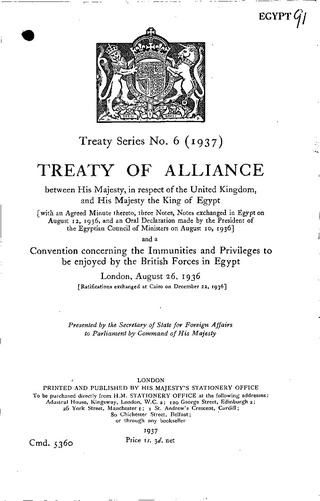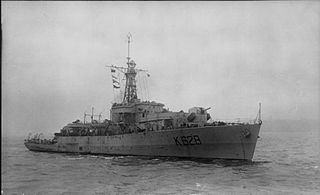
The British Armed Forces are the military forces responsible for the defence of the United Kingdom, its Overseas Territories and the Crown Dependencies. They also promote the UK's wider interests, support international peacekeeping efforts and provide humanitarian aid.

The Suez Crisis or the Second Arab–Israeli War, also referred to as the Tripartite Aggression in the Arab world and as the Sinai War in Israel, was a British–French–Israeli invasion of Egypt in 1956. Israel invaded on 29 October, having done so with the primary objective of re-opening the Straits of Tiran and the Gulf of Aqaba as the recent tightening of the eight-year-long Egyptian blockade further prevented Israeli passage. After issuing a joint ultimatum for a ceasefire, the United Kingdom and France joined the Israelis on 5 November, seeking to depose Egyptian president Gamal Abdel Nasser and regain control of the Suez Canal, which Nasser had earlier nationalised by transferring administrative control from the foreign-owned Suez Canal Company to Egypt's new government-owned Suez Canal Authority. Shortly after the invasion began, the three countries came under heavy political pressure from both the United States and the Soviet Union, as well as from the United Nations, eventually prompting their withdrawal from Egypt. Israel's four-month-long occupation of the Egyptian-occupied Gaza Strip and Egypt's Sinai Peninsula enabled it to attain freedom of navigation through the Straits of Tiran, but the Suez Canal itself was closed from October 1956 to March 1957. The Suez Crisis led to international humiliation for the British and the French in the wake of the Cold War, which established the Americans and the Soviets as the world's superpowers. It also strengthened Nasser's standing.

Hamad bin Isa bin Salman Al Khalifa is King of Bahrain since 14 February 2002, after ruling as Emir of Bahrain from 6 March 1999.

The Anglo-Egyptian Treaty of 1936 was a treaty signed between the United Kingdom and the Kingdom of Egypt.

HMS Loch Killisport (K628/F628) was a Loch-class frigate of the British Royal Navy, named after Loch Killisport in Scotland. Launched in 1944, the ship was not commissioned until July 1945, and served in post-war repatriation operations in the Far East until decommissioned in April 1946. During this time Prince Philip was an officer on board this ship. Recommissioned in 1950 she served in the Home Fleet for two years, before being extensively modernised for service in the Persian Gulf and Far East. Decommissioned in August 1965, she was sold for scrapping in 1970.
The 1966 Defence White Paper was a major review of the United Kingdom's defence policy initiated by the Labour government under Prime Minister Harold Wilson. The review was led by the Secretary of State for Defence, Denis Healey. The document was centred on the need to support NATO in Europe and made the commitment that the UK, "would not undertake major operations of war except in co-operation with allies." The 1966 announcements undertook to retain the UK presence in Singapore and Malaysia.

In military strategy, a choke point, or sometimes bottleneck, is a geographical feature on land such as a valley, defile or bridge, or maritime passage through a critical waterway such as a strait, which an armed force is forced to pass through in order to reach its objective, sometimes on a substantially narrowed front and therefore greatly decreasing its combat effectiveness by making it harder to bring superior numbers to bear. A choke point can allow a numerically inferior defending force to use the terrain as a force multiplier to thwart or ambush a much larger opponent, as the attacker cannot advance any further without first securing passage through the choke point.

Middle East Command, later Middle East Land Forces, was a British Army Command established prior to the Second World War in Egypt. Its primary role was to command British land forces and co-ordinate with the relevant naval and air commands to defend British interests in the Middle East and eastern Mediterranean region.

His Majesty's Naval Base, Singapore, also Her Majesty's Naval Base, Singapore, alternatively known as the Singapore Naval Base, Sembawang Naval Base and HMS Sembawang, was situated in Sembawang at the northern tip of Singapore and was both a Royal Navy shore establishment and a cornerstone of British defence policy in the Far East between the World Wars. From 1921 to 1941 it was a China Station base, from 1941 to 1945 a repair facility for the Imperial Japanese Navy and from 1945 to 1958 a Far East Fleet base. Today, it is a commercial dockyard but British military activity still exists at the British Defence Singapore Support Unit (BDSSU).
This article deals with territorial disputes between states of in and around the Persian Gulf in Southwestern Asia. These states include Iran, Iraq, Kuwait, Saudi Arabia, Bahrain, Qatar, the United Arab Emirates (UAE), and Oman.
An All-Red Route was, originally, a steamship route used by Royal Mail Ships during the heyday of the British Empire. The name derives from the common practice of colouring the territory of the British Empire red or pink on political maps. It denoted a long-distance route where all the ports of call were in British territories or colonies, emphasising not only the usefulness of the route as a means of connecting the British metropole with the worldwide empire but also the strategic security of being able to connect possessions on the other side of the globe without having to rely on making stops in, or passing through, the territory of another nation.

The Trucial States, also known as the Trucial Coast, the Trucial Sheikhdoms, Trucial Arabia or Trucial Oman, was a group of tribal confederations to the south of the Persian Gulf whose leaders had signed protective treaties, or truces, with the United Kingdom between 1820 and 1892.

The United Kingdom Naval Support Facility is a Royal Navy base established in Bahrain on 13 April 1935, as part of the port at Mina Salman. In 1950, the United States Navy leased space in HMS Jufair and following Bahraini independence in 1971, took over the base. On 6 December 2014, it was announced that HMS Jufair would be reestablished as a permanent Royal Navy base. On 5 April 2018, the UK Naval Support Facility was officially opened by the Crown Prince of Bahrain, Salman bin Hamad Al Khalifa and The Duke of York, representing the United Kingdom.

The Foreign Ministry is the government body in the Sultanate of Oman responsible for organising and directing Oman's relations with other countries and with regional and international organisations.
The Middle East region plays a vital role in India's economy as it supplies nearly two-thirds of India's total oil import, bilateral trade is also flourishing in recent years particularly with UAE and other Arab states of the Persian Gulf. Over the years, millions of Indians mostly working class have migrated to the Persian Gulf region looking for jobs and they account for a sizeable share in the total remittances received from abroad. Indian External Affairs Ministry refers the region as West Asia and not as Middle East which is a more popular attribution, particularly in the Western countries.

Overseas military bases of the United Kingdom enable the British Armed Forces to conduct expeditionary warfare and maintain a forward presence. Bases tend to be located in or near areas of strategic or diplomatic importance, often used for the build-up or resupply of military forces, as was seen during the 1982 Falklands War and the use of RAF Ascension Island as a staging post. Most of the bases are located on British Overseas Territories or former colonies which retain close diplomatic ties with the British government.

British foreign policy in the Middle East has involved multiple considerations, particularly over the last two and a half centuries. These included maintaining access to British India, blocking Russian or French threats to that access, protecting the Suez Canal, supporting the declining Ottoman Empire against Russian threats, guaranteeing an oil supply after 1900 from Middle East fields, protecting Egypt and other possessions in the Middle East, and enforcing Britain's naval role in the Mediterranean. The timeframe of major concern stretches from the 1770s when the Russian Empire began to dominate the Black Sea, down to the Suez Crisis of the mid-20th century and involvement in the Iraq War in the early 21st. These policies are an integral part of the history of the foreign relations of the United Kingdom.

The United Kingdom Joint Logistics Support Base (UKJLSB) is a military base located within the Al Duqm Port and Drydock of Duqm in the Al Wusta governorate of Oman. As a British overseas military base, it is used to facilitate the deployment of the British Armed Forces in the Persian Gulf and Indian Ocean, along with the wider British maritime operations in the region.

Open slavery existed in Bahrain until the 1930s. Slavery was formally abolished in Bahrain in 1937. Slavery ended earlier in Bahrain than in any other Gulf state, with the exception of Iran and Iraq. Many members of the Afro-Arabian minority are descendants of the former slaves. Slavery of people from Africa and East Asia was succeeded by the modern Kafala system of poor workers from the same region were slaves had previously been imported.















